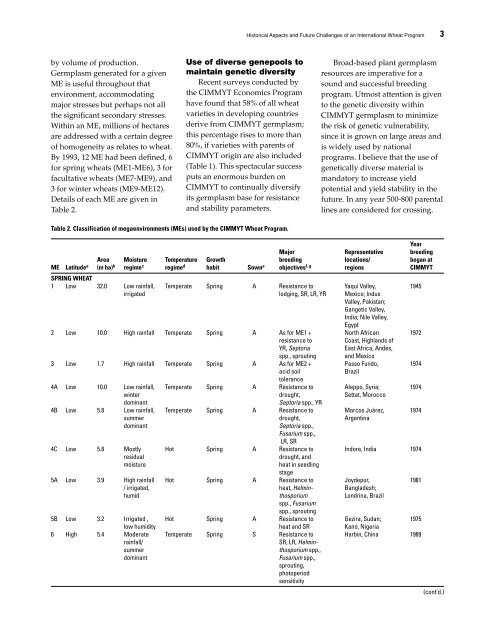Septoria and Stagonospora Diseases of Cereals - CIMMYT ...
Septoria and Stagonospora Diseases of Cereals - CIMMYT ...
Septoria and Stagonospora Diseases of Cereals - CIMMYT ...
You also want an ePaper? Increase the reach of your titles
YUMPU automatically turns print PDFs into web optimized ePapers that Google loves.
y volume <strong>of</strong> production.<br />
Germplasm generated for a given<br />
ME is useful throughout that<br />
environment, accommodating<br />
major stresses but perhaps not all<br />
the significant secondary stresses.<br />
Within an ME, millions <strong>of</strong> hectares<br />
are addressed with a certain degree<br />
<strong>of</strong> homogeneity as relates to wheat.<br />
By 1993, 12 ME had been defined, 6<br />
for spring wheats (ME1-ME6), 3 for<br />
facultative wheats (ME7-ME9), <strong>and</strong><br />
3 for winter wheats (ME9-ME12).<br />
Details <strong>of</strong> each ME are given in<br />
Table 2.<br />
Table 2. Classification <strong>of</strong> megaenvironments (MEs) used by the <strong>CIMMYT</strong> Wheat Program.<br />
Historical Aspects <strong>and</strong> Future Challenges <strong>of</strong> an International Wheat Program 3<br />
Use <strong>of</strong> diverse genepools to<br />
maintain genetic diversity<br />
Recent surveys conducted by<br />
the <strong>CIMMYT</strong> Economics Program<br />
have found that 58% <strong>of</strong> all wheat<br />
varieties in developing countries<br />
derive from <strong>CIMMYT</strong> germplasm;<br />
this percentage rises to more than<br />
80%, if varieties with parents <strong>of</strong><br />
<strong>CIMMYT</strong> origin are also included<br />
(Table 1). This spectacular success<br />
puts an enormous burden on<br />
<strong>CIMMYT</strong> to continually diversify<br />
its germplasm base for resistance<br />
<strong>and</strong> stability parameters.<br />
Broad-based plant germplasm<br />
resources are imperative for a<br />
sound <strong>and</strong> successful breeding<br />
program. Utmost attention is given<br />
to the genetic diversity within<br />
<strong>CIMMYT</strong> germplasm to minimize<br />
the risk <strong>of</strong> genetic vulnerability,<br />
since it is grown on large areas <strong>and</strong><br />
is widely used by national<br />
programs. I believe that the use <strong>of</strong><br />
genetically diverse material is<br />
m<strong>and</strong>atory to increase yield<br />
potential <strong>and</strong> yield stability in the<br />
future. In any year 500-800 parental<br />
lines are considered for crossing.<br />
Major Representative<br />
Year<br />
breeding<br />
Area Moisture Temperature Growth breeding locations/ began at<br />
ME Latitudea (m ha) b regimec regimed habit Sowne objectivesf, g regions <strong>CIMMYT</strong><br />
SPRING WHEAT<br />
1 Low 32.0 Low rainfall, Temperate Spring A Resistance to Yaqui Valley, 1945<br />
irrigated lodging, SR, LR, YR Mexico; Indus<br />
Valley, Pakistan;<br />
Gangetic Valley,<br />
India; Nile Valley,<br />
Egypt<br />
2 Low 10.0 High rainfall Temperate Spring A As for ME1 + North African 1972<br />
resistance to Coast, Highl<strong>and</strong>s <strong>of</strong><br />
YR, <strong>Septoria</strong> East Africa, Andes,<br />
spp., sprouting <strong>and</strong> Mexico<br />
3 Low 1.7 High rainfall Temperate Spring A As for ME2 + Passo Fundo, 1974<br />
acid soil<br />
tolerance<br />
Brazil<br />
4A Low 10.0 Low rainfall, Temperate Spring A Resistance to Aleppo, Syria; 1974<br />
winter drought, Settat, Morocco<br />
dominant <strong>Septoria</strong> spp., YR<br />
4B Low 5.8 Low rainfall, Temperate Spring A Resistance to Marcos Juárez, 1974<br />
summer drought, Argentina<br />
dominant <strong>Septoria</strong> spp.,<br />
Fusarium spp.,<br />
LR, SR<br />
4C Low 5.8 Mostly Hot Spring A Resistance to Indore, India 1974<br />
residual drought, <strong>and</strong><br />
moisture heat in seedling<br />
stage<br />
5A Low 3.9 High rainfall Hot Spring A Resistance to Joydepur, 1981<br />
/ irrigated, heat, Helmin- Bangladesh;<br />
humid thosporium<br />
spp., Fusarium<br />
spp., sprouting<br />
Londrina, Brazil<br />
5B Low 3.2 Irrigated , Hot Spring A Resistance to Gezira, Sudan; 1975<br />
low humidity heat <strong>and</strong> SR Kano, Nigeria<br />
6 High 5.4 Moderate Temperate Spring S Resistance to Harbin, China 1989<br />
rainfall/ SR, LR, Helminsummer<br />
thosporium spp.,<br />
dominant Fusarium spp.,<br />
sprouting,<br />
photoperiod<br />
sensitivity<br />
(cont’d.)









